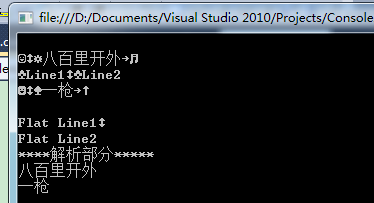[转]序列化悍将Protobuf-Net,入门动手实录
最近在研究web api 2,看了一篇文章,讲解如何提升性能的,

在序列化速度的跑分中,Protobuf一骑绝尘,序列化速度快,性能强,体积小,所以打算了解下这个利器
1:安装篇
谷歌官方没有提供.net的实现,所以在nuget上找了一个移植的

Nuget里搜索Protobuf-net,下载,自动添加到项目中
2:定义数据结构
using ProtoBuf;
namespace ConsoleApplication1
{
[ProtoContract]
class Person
{
[ProtoMember(1)]
public int Id { get; set; }
[ProtoMember(2)]
public string Name { get; set; }
[ProtoMember(3)]
public Address Address { get; set; }
}
[ProtoContract]
class Address
{
[ProtoMember(1)]
public string Line1 { get; set; }
[ProtoMember(2)]
public string Line2 { get; set; }
}
}
3:封装简单操作类
按照作者使用习惯,简单提供了一个Helper类
using System.IO;
using System.Text;
using ProtoBuf;
namespace ConsoleApplication1
{
public class ProtobufHelper
{
/// <summary>
/// 序列化
/// </summary>
/// <typeparam name="T"></typeparam>
/// <param name="t"></param>
/// <returns></returns>
public static string Serialize<T>(T t)
{
using (MemoryStream ms = new MemoryStream())
{
Serializer.Serialize<T>(ms, t);
return Encoding.UTF8.GetString(ms.ToArray());
}
}
/// <summary>
/// 反序列化
/// </summary>
/// <typeparam name="T"></typeparam>
/// <param name="content"></param>
/// <returns></returns>
public static T DeSerialize<T>(string content)
{
using (MemoryStream ms = new MemoryStream(Encoding.UTF8.GetBytes(content)))
{
T t = Serializer.Deserialize<T>(ms);
return t;
}
}
}
}
4:操作体验
代码很简单,就不分开贴了
using System;
using System.Collections.Generic;
using System.IO;
namespace ConsoleApplication1
{
class Program
{
static void Main(string[] args)
{
var p1 = new Person
{
Id = 1,
Name = "八百里开外",
Address = new Address
{
Line1 = "Line1",
Line2 = "Line2"
}
};
var p2 = new Person
{
Id = 2,
Name = "一枪",
Address = new Address
{
Line1 = "Flat Line1",
Line2 = "Flat Line2"
}
};
List<Person> pSource = new List<Person>() { p1, p2 };
string content = ProtobufHelper.Serialize<List<Person>>(pSource);
Console.Write(content);
//写入文件
File.WriteAllText("D://hello.txt", content);
Console.WriteLine("\r\n****解析部分*****");
List<Person> pResult = ProtobufHelper.DeSerialize<List<Person>>(content);
foreach (Person p in pResult)
{
Console.WriteLine(p.Name);
}
Console.Read();
}
}
}
控制台运行结果

同样的数据,和Json所占用空间对比,高下立判

后记
protobuf虽然有千般好,但是我们是在 web api上使用的,前台js解析不了Protobuf,所以只能用Json咯~!
StackService虽然Github上有2K多个Star,但是收费的。。同样的事情web api 2也能做到,所以也略过它。
最终作者选择了跑分测试里面的第二名Jil https://github.com/kevin-montrose/Jil
1. With very minimal annotation on the class level
[ProtoContract(ImplicitFields = ImplicitFields.AllPublic)] // only required on the class level class PersonEntity { public string FirstName { get; set; } public string LastName { get; set; } }
2. Without any annotation (using RuntimeTypeModel)
static void InitializeProtobufRunTime() { var assembly = Assembly.GetAssembly(typeof(PlainEntities.PersonEntity)); var types = assembly.GetTypes(); foreach (var t in types.Where(x => x.Namespace.Contains("PlainEntities"))) { Console.WriteLine("Processing {0}", t.FullName); var meta = RuntimeTypeModel.Default.Add(t, false); var index = 1; // find any derived class for the entity foreach (var d in types.Where(x => x.IsSubclassOf(t))) { var i = index++; Console.WriteLine("\tSubtype: {0} - #{1}", d.Name, i); meta.AddSubType(i, d); } // then add the properties foreach (var p in t.GetProperties(BindingFlags.Instance | BindingFlags.Public | BindingFlags.DeclaredOnly).Where(x => x.GetSetMethod() != null)) { var i = index++; Console.WriteLine("\tProperty: {0} - #{1}", p.Name, i); meta.AddField(i, p.Name); } } }
And both the above works quite well without any performance differences.
------------------
TestBinaryEntities
------------------
Process: 100000 items, MemorySize: 7400705, Completed in: 3877 ms, Serialization took: 676 ms, Deserialization took: 2948 ms
----------------------------------
TestProtobufFullyAnnotatedEntities
----------------------------------
Process: 100000 items, MemorySize: 3983490, Completed in: 682 ms, Serialization took: 164 ms, Deserialization took: 253 ms
-------------------------------------
TestProtobufImplicitAnnotatedEntities
-------------------------------------
Process: 100000 items, MemorySize: 3983490, Completed in: 595 ms, Serialization took: 104 ms, Deserialization took: 210 ms
-------------------------------
TestProtobufRuntimeRegistration
-------------------------------
Processing ProtobufTestConsole.PlainEntities.BaseEntity
Subtype: PersonEntity - #1
Property: Id - #2
Property: Gender - #3
Processing ProtobufTestConsole.PlainEntities.PersonEntity
Property: FirstName - #1
Property: LastName - #2
Property: Age - #3
Process: 100000 items, MemorySize: 4083490, Completed in: 646 ms, Serialization took: 113 ms, Deserialization took: 232 ms
Looking forward to get this in :)
Also attached the sample project for reference



